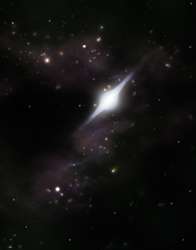Unraveling galactic, stellar evolution through study of supermassive stars

European research is identifying and quantifying properties of massive stars in our galaxy and nearby. This research should provide important insight into the formation of galaxies and stellar evolution.
Until recently, experimental evidence suggested that the upper mass limit on stars was about 150 times that of our Sun. While it may actually be nearly two times that according to new evidence, much is left to be learned about massive star formation, stellar evolution and the elusive stellar mass limit.
Massive stars with their tremendous gravitational pulls may be important drivers of and windows into the evolution of galaxies. European researchers sought to extend a comprehensive study of the most massive stars in the local Universe, namely in our Milky Way galaxy and nearby galaxies.
With EU funding of 'The most massive stars in the local universe' (Mostmassivestars) project, scientists are discovering massive stars in eclipsing binaries and measuring parameters to provide important constraints on their formation and evolution.
Binary stars are two-star systems in which the brightest (primary) star and its companion (secondary) orbit around their centre of mass. Just as with our planets, orbit of the stars is governed by the gravitational pull each exerts on the other that is in turn related to mass. Thus, binary star systems provide a window into masses of the component stars, enabling indirect calculation of radius and density.
Eclipsing binaries are systems in which the orbit plane is along the line of sight of an observer such that the one eclipses the other, thus periodically providing additional information offered by changes in observed intensity. Measurements of periodic changes in brightness allow calculation of elemental compositions (e.g. metallicities or portion of stars not made of hydrogen and helium).
Metallicity may provide information on the age of a star given that, according to the Big Bang theory, when the Universe was formed it consisted almost entirely of hydrogen that then created significant helium. Older stars thus tend to have lower metallicities than younger ones.
The Mostmassivestars team measured fundamental parameters of massive eclipsing binaries with high accuracy. The data will enable testing of stellar atmosphere models, wind models and stellar evolution models as a function of metallicity and predictions of upper mass limits of stars.
Provided by CORDIS





















